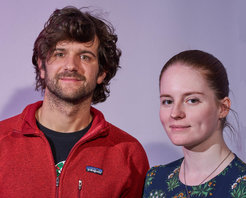Again EUROFusion Grants for young E2M Scientists
Already repeatedly young E2M scientists have managed to obtain EUROFusion researcher grants. We reported about such success already in 2017 and 2015, see below. This time Anna Medvedeva and Marco Cavedon applied successfully. The following brief summaries inform about their projects:
Anna Medvedeva:
Dynamics of turbulent structures
Plasma confinement in a tokamak is limited by turbulence. One major challenge scientists are facing is to explain the dynamics of the turbulent structures and their influence on plasma confinement. Understanding how turbulence self-organizes is the key to describe the edge transport barrier formation in H-mode plasmas. The electric field driven by turbulence creates a flow which itself regulates the turbulence. Transient or lasting structures appear in the course of this dynamics. The related features are labelled as “zonal flows”, “avalanches”, or “staircases”.
The project is oriented to the experimental search and understanding of flows and avalanches and their influence on turbulent transport as well as on the L-H transition. To this end, advantage will be taken of the high resolution capabilities of the ultra-fast swept reflectometer to explore, in collaboration with CEA, Cadarache, possible indications of staircases in the existing database of ASDEX Upgrade and in the future WEST.

Marco Cavedon:
Investigations towards an understanding of the L-H-transition
The most promising scenario for future fusion devices like ITER is the high confinement mode (H-mode) which was firstly discovered at ASDEX in 1982. In comparison to the low confinement mode (L-mode), it is characterized by the formation of an edge transport barrier resulting in an improvement of the confinement which makes future fusion devices more efficient and more economical.
Although more than 30 years of worldwide research have passed, our physics knowledge of the L-H transition has not yet lead to a reliable prediction of H-mode onset. Within this research project, a new diagnostic is installed at ASDEX Upgrade to measure the ExB velocity (vExB) at the plasma edge and in the scrape-off layer. vExB is predicted to be responsible for the turbulence suppression at the edge thus leading to the establishment of the H-mode. The new diagnostic will give new insights into L-H transition physics helping to tackle unanswered questions crucial for the design of any future fusion device.
